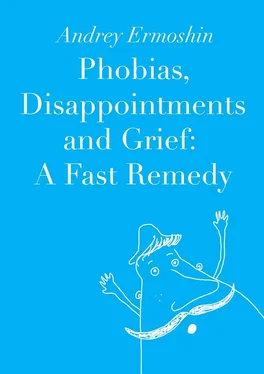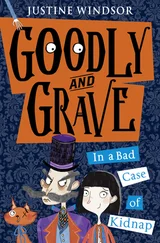In the process of self-regulation Boris let this “dark soup” spill out away from his body. His spine become “whole” again.
He also created a backup plan for possible similar situations. Should he carry a gun? That would be too much. Should he call the police? Sounds much better. Should he call the authorities or should he just deny all the demands of these racketeers? While Boris was considering his options, he went back to his feelings. In his inner vision toads and crocodiles begin to jump out of his back. These were his fears which he had been accumulating about meeting strangers on the road. Then there were numerous pictures of corpses coming from the back of his head. These were the words of eyewitnesses, coming mainly from TV programmes. During the “tough” nineties in Russia one heard endless stories about highwaymen. Their trick was to use falsified evidence as an excuse to intimidate their victims.
Closer to the end of the session Boris made a sensible decision:
“If I ever meet such people again, I will be firm, write down their number plate, call the police and tell them that my insurance will cover it.”
These words are the evidence of the reverse process: that “dark soup” was pouring out of his kidneys, those “toads and crocodiles” were coming out of his spine, and the “pictures of corpses” were “flying out” from the back of his head.
After the session Boris felt like a new man.
1.4. Other ways of working with phobias
Hypnosis and archaic practices
Once a woman who was suffering from a fear of planes came to an appointment with the famous hypnosis specialist Milton H. Erickson. The doctor sensitized her for an imaginary flight and made her believe that if she landed safely, her fear would slide off the seat and be gone. When the patient realized that, she jumped up from the seat screaming “It’s contagious!” and wouldn’t let the doctor’s wife, Mrs. Erickson, sit on this seat, trying to protect her from the danger. This is another way of working with phobias. One more example is the practice of “ebbing the fear” which comes from traditional practitioners. They part from the idea that fear goes into the body. Then the healers create a special condition to remove fear from the body. The healer pronounces the spell and pours melted wax into a bowl filled with water that is held above the patient’s head. Both the healer and the patient expect the fear to move to the wax. When the wax solidifies in the water, the form it takes should reveal the real former fear of the patient. For example, if the patient was afraid of dogs, the wax might take the shape of a dog’s face. This also serves as proof for the patient that the fear is gone. When I went to Bashkiria, I learnt how fear was understood in the local shaman practice. During the seminar, there was one participant who was really interested in the customs and traditions of her people. According to her, the moment the person is frightened, he or she loses a part of their good soul, and a dark spirit settles inside.The task of the shaman is to find the lost part of the soul and send away what wrongfully entered the body. I would say it partly looks like what we witness during the psychotherapy sessions. What is the difference then?
Expecting a miracle
In the above-mentioned examples a patient is looking forward to the fear moving away, be it sliding on the seat, pouring into the wax or going to the centre of the Earth (which is what shamans in Siberia do). Expectation should trigger some sort of work in the body which will eventually lead to the healing. However, neither hypnotist, nor healers nor shamans tell you how exactly this result is achieved. It is impossible to trace what is hidden in the core of the process. There’s only the expectation of the miracle .
Both parties, the healer and the patients, hopethat liberation will take place. This is an option of “righteous expectation therapy’: if you hope for something positive, it will definitely happen. Nevertheless, the result is not at all guaranteed because the whole process is delegated to the subconscious, and it just cannot do all the work by itself. The patient cannot just play a passive role in this process.
Trance is not enough
Neither auto-training (autosuggestion), nor meditation of the general character really work in case of phobias and other traumas. “Formulae of auto-training” set the idea of striving for an ideal condition but they do not offer any step-by-step instructions on how turn a halted psychological process around. In serious cases these methods are futile. Trance as such, without any active participation of consciousness, can be healing but it might be considered more like luck rather than an efficient method. The same applies to other methods which are aimed at non-directive activation of nervous and psychological processes (holotropic breathing, etc.)
To understand is not enough
There are completely opposite approaches which presuppose addressing the intelligence of the patient: “Don’t you see that your fears are ridiculous, and that you can easily overcome them?“Of course, such kind of understanding is important but it is not enough for healing oneself from fear. Increasing one’s level of competence doesn’t have that much influence at the autonomic level. The head can understand that there is nothing to be afraid of, but once the object of fear is mentioned, a sinking feeling will appear in the stomach.
There’s a curious story about a patient in therapy who imagined that he was a seed and was afraid of being pecked by a rooster. After various therapeutic sessions his doctor asked him: “Well, do you understand that you are not a seed?” – “Of course, I do! I am a person!” – “Will you go home without worries?” – “No, doctor.” – “Why?” – “Because I know I’m not a seed, but does the rooster know?”
Understanding creates some background which can make further work with the autonomic nervous system more efficient but unfortunately it cannot automatically unblock the initial reactions of the body.
Synthetic practices
One should pay special attention to the following synthetic practices based on Pavlov’s neurophysiological research.
Ivan Petrovich Pavlov (1849—1936) and his supporters while studying the physiology of nervous processes came to the conclusion that in cases of impulsive obsessions, nervous processes lose their typical agility, there is certain inertia of nervous processes, and it manifests in congestive centres. (Pavlov, 1950).
Joseph Wolpe (1915 – 1997) was a South African psychiatrist who parted from Pavlov’s research of conditioned reflexes and developed a concept of neurotic fears from the point of view of learning theory. At a certain moment “a body learnt” to treat some factor with fear. Now it has to learn how to stop doing this. “If your fears are automatic emotional habits, then you will have to use different emotions to destroy these habits. If some of your fears appeared due to disinformation then we will provide correct information (Wolpe, 1982, p.87). He introduced “systematic desensitization’: a patient is brought to a very relaxed state and then he or she is subjected to a light stimulus that causes fear. Once the patient has acquired tolerance to such a level of anxiety, the dose of the stimulus is gradually increased until the patient gets accustomed to the bigger dosage and considers it low, which would then lead to a decrease of anxiety. (Wolpe, 1958, 1961). This approach was named, behavioural therapy.
It is essential that the process of adaptation is gradual, and it is based on the fact that the patient is relaxed and well informed. However, there is one issue that is left out when this approach is taken. The signal that has gone deep into the body and that has activated the autonomic system is ignored. Thus the new reaction is imposed “over” the old one. This slows down the treatment and doesn’t actually set the patient completely free from his or her internal fear fighting.
Читать дальше












